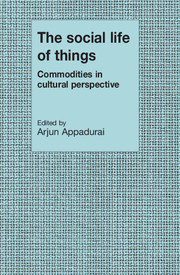Book contents
- Frontmatter
- Contents
- Contributors
- Foreword
- Preface
- Part I Toward an anthropology of thing
- Part II Exchange, consumption, and display
- 3 Two kinds of value in the Eastern Solomon Islands
- 4 Newcomers to the world of goods: consumption among the Muria Gonds
- Part III Prestige, commemoration, and value
- Part IV Production regimes and the sociology of demand
- Part V Historical transformations and commodity codes
- Index
4 - Newcomers to the world of goods: consumption among the Muria Gonds
Published online by Cambridge University Press: 05 June 2014
- Frontmatter
- Contents
- Contributors
- Foreword
- Preface
- Part I Toward an anthropology of thing
- Part II Exchange, consumption, and display
- 3 Two kinds of value in the Eastern Solomon Islands
- 4 Newcomers to the world of goods: consumption among the Muria Gonds
- Part III Prestige, commemoration, and value
- Part IV Production regimes and the sociology of demand
- Part V Historical transformations and commodity codes
- Index
Summary
The theme of this paper is consumption as a form of symbolic action. Consumption goods are more than mere packets of neutral “utility.” They are objects made more or less desirable by the role they play in a symbolic system. I will develop this entirely uncontroversial proposition on the basis of my observations of consumption behavior among the Muria of the north-central part of Bastar district, Madhya Pradesh, India.
The Muria belong to the “tribal” (adivasi) category established by the constitution of India, and according to the official stereotype of such groups they ought to be mired in poverty and exploitation. The official stereotype is not wide of the mark so far as most of the adivasi population are concerned (Fürer-Haimendorf 1982), but conditions in north-central Bastar are exceptional, for here the Muria enjoy considerable material advantages by comparison with small peasants elsewhere in the subcontinent (see Hill 1983). I will try to explain how this has come about in due course.
Amid the modest prosperity, or at least security, now enjoyed by most of the Muria population in north-central Bastar, one or two families in each village have enriched themselves to a greater degree than most, and it is on the consumption behavior of such rich Muria families that I wish to focus particular attention. I believe that “rich” Muria are a relatively new phenomenon, dating back no more than fifty years or so, and that this may help explain why their consumption behavior, which is marked by an exaggerated conservatism, assumes the rather peculiar form it does.
- Type
- Chapter
- Information
- The Social Life of ThingsCommodities in Cultural Perspective, pp. 110 - 138Publisher: Cambridge University PressPrint publication year: 1986
- 54
- Cited by



